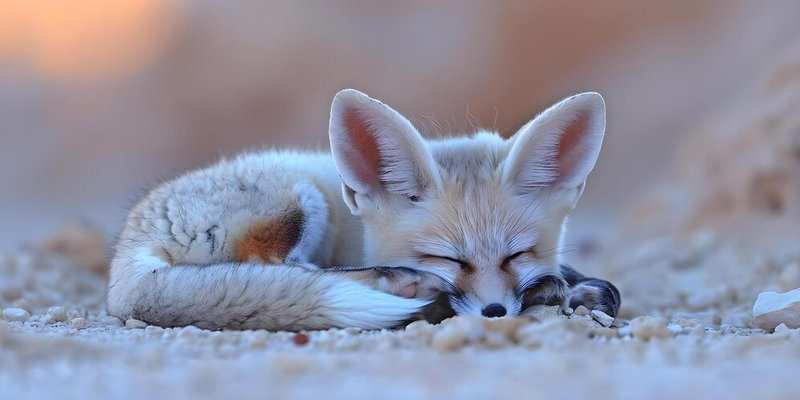
Fennec foxes are masters of survival, equipped with unique features and clever behaviors that help them thrive where most would struggle. They remind me a bit of those crafty characters in movies who sneak around and figure things out against all odds. So, how do fennec foxes manage to call the harsh desert home? Let’s dig in and explore their secrets.
Unique Adaptations to Extreme Heat
First off, let’s talk about those big ears. Honestly, they’re not just for show. Fennec foxes have ears that can be as long as 6 inches! These large ears serve a couple of important purposes. For one, they help dissipate heat. The more surface area you have, the easier it is to release body heat. Think of them as built-in air conditioners!
Additionally, their keen hearing allows them to detect prey, like insects or small rodents, even when they’re underground. This is crucial in the desert where food sources are often scarce. Fennec foxes can munch on small animals and even take advantage of the occasional fruit or plant that pops up. Their body’s ability to conserve water is another vital adaptation. They can actually go weeks without drinking water, getting most of their hydration from food.
Mastering Nocturnal Living
Here’s the thing: fennec foxes are nocturnal, which means they’re most active at night. This behavior is another survival tactic in the harsh desert climate, where daytime temperatures can soar. By coming out after the sun sets, these foxes avoid the extreme heat and can hunt or scavenge more comfortably.
But being active at night doesn’t just keep them cooler; it also helps them escape predators. Many larger animals are either asleep or resting during those cooler hours, giving the fennec fox a better chance to roam free. Think about it—how many times have you been out on a peaceful evening walk and felt like the world is yours? For these little foxes, nighttime is when they truly thrive.
Shelter and Burrow Systems
Fennec foxes are also exceptional diggers. They create extensive burrow systems underground, which serve multiple purposes. Not only do these burrows protect them from the harsh elements, but they also provide a safe place to raise their young.
Their burrows can reach depths of 3 to 4 feet and can be as long as 30 feet! This system is like their cozy little home in the middle of a sandy ocean. Inside, the temperature remains much cooler compared to the surface. It’s a smart way to stay safe and comfy while the desert sun beats down.
A Specialized Diet for Desert Living
You might be wondering what fennec foxes eat out in the wild. Their diet is quite varied but very specialized for desert living. Primarily, they feast on small rodents, birds, and insects. They also munch on fruits and plants when they can find them.
Here’s a fun fact: their diet is so flexible that they can adjust based on what’s available at different times of the year. During dry seasons, they might go after insects more frequently, while in wetter times, they might hunt small mammals. This adaptability helps them survive when food is hard to come by.
Water Conservation Techniques
Water is precious in the desert, and fennec foxes have developed fascinating ways to conserve it. As mentioned earlier, they get most of their hydration from their food. But that’s not all. These foxes have kidneys that are super efficient at retaining water, so they lose far less through urine than many other animals.
Additionally, they can reduce the amount of water lost through perspiration. Instead of sweating, which can lead to dehydration, these clever creatures cool themselves through their ears. They’ve truly mastered the art of living in extreme conditions!
Social Behavior and Family Life
Fennec foxes aren’t just lone wanderers; they have social structures, too. They often live in small family groups, which helps them cooperate in finding food and raising their young. Family units usually consist of a breeding pair and their kits.
You might have seen videos or photos of playful kits frolicking in the sand—these interactions are vital for social bonding and learning survival skills. Family members communicate through a variety of sounds, from barks to purrs. It’s a little like their own unique language, which helps them stay connected in the vast desert.
The Impact of Climate Change
As we dive deeper into the survival of fennec foxes, we can’t ignore how climate change impacts their environment. Rising temperatures and changes in weather patterns can threaten their delicate habitat. With less rainfall, food sources may dwindle, and their survival tactics might be put to the test.
Conservation efforts are crucial to ensuring that these adorable creatures continue to thrive. Protecting their habitats and promoting awareness about their needs can help fennec foxes adapt to these changing conditions. After all, if they lose their home, it becomes much harder for them to survive.
In a nutshell, fennec foxes are incredible survivors. From impressive adaptations like their big ears to their nocturnal habits and clever use of burrow systems, they’re perfectly tuned to their harsh desert environment. These little creatures remind us that life can flourish even in the most challenging conditions.
So, the next time you hear about a fennec fox, remember the amazing ways they navigate their world. Their journey of survival is not only fascinating but also inspires hope and respect for the resilience of nature.
